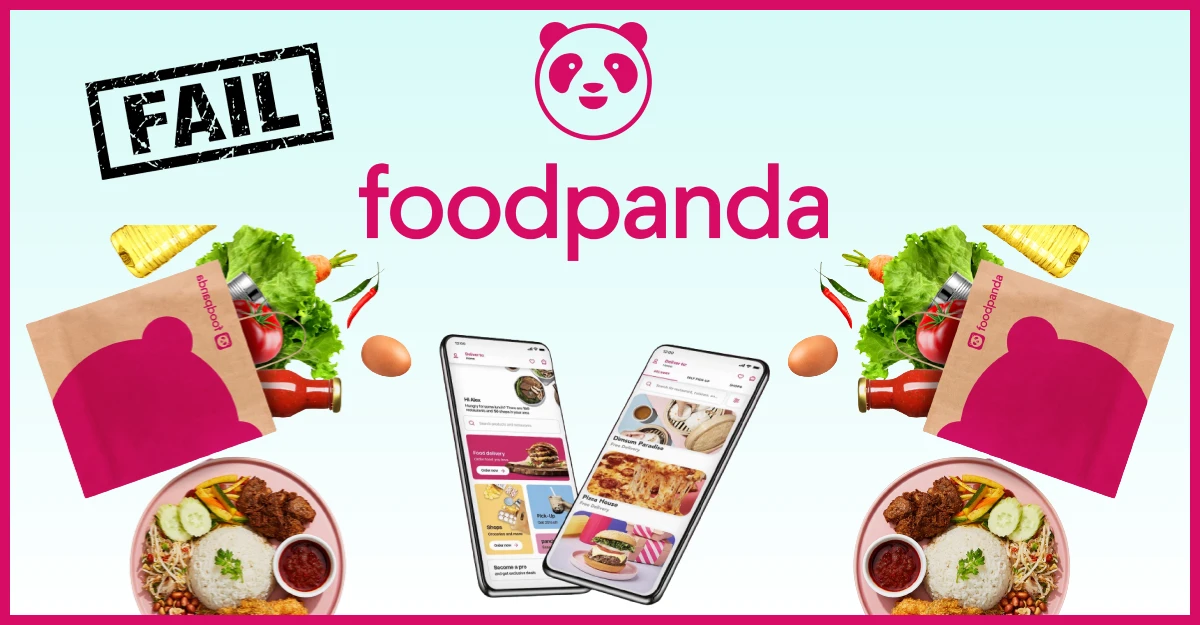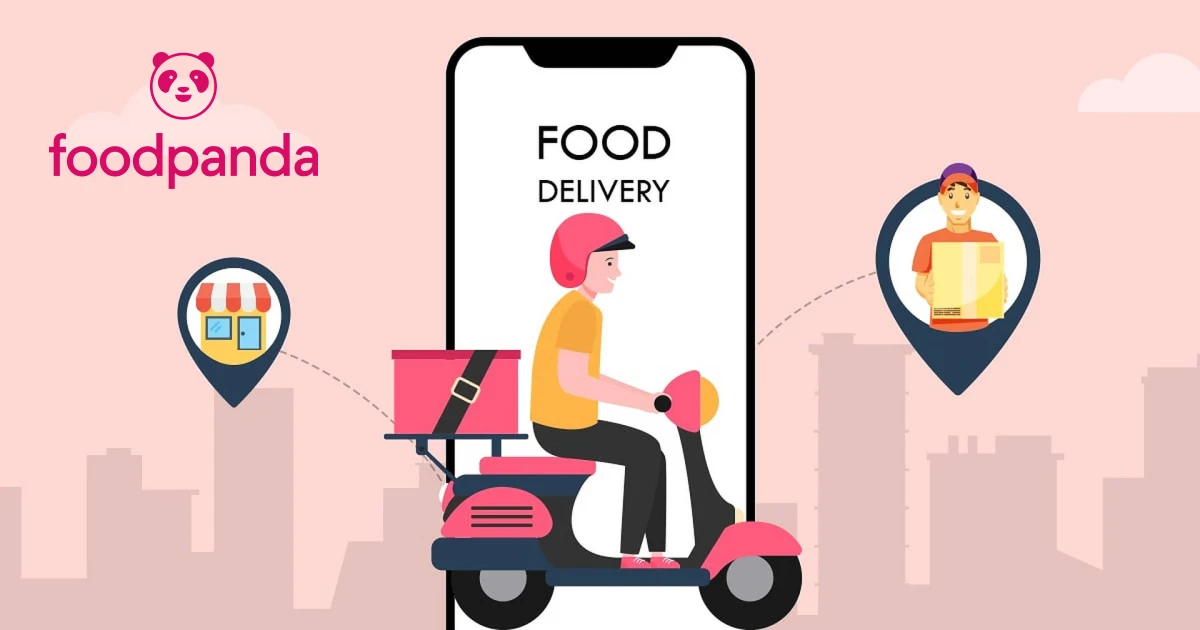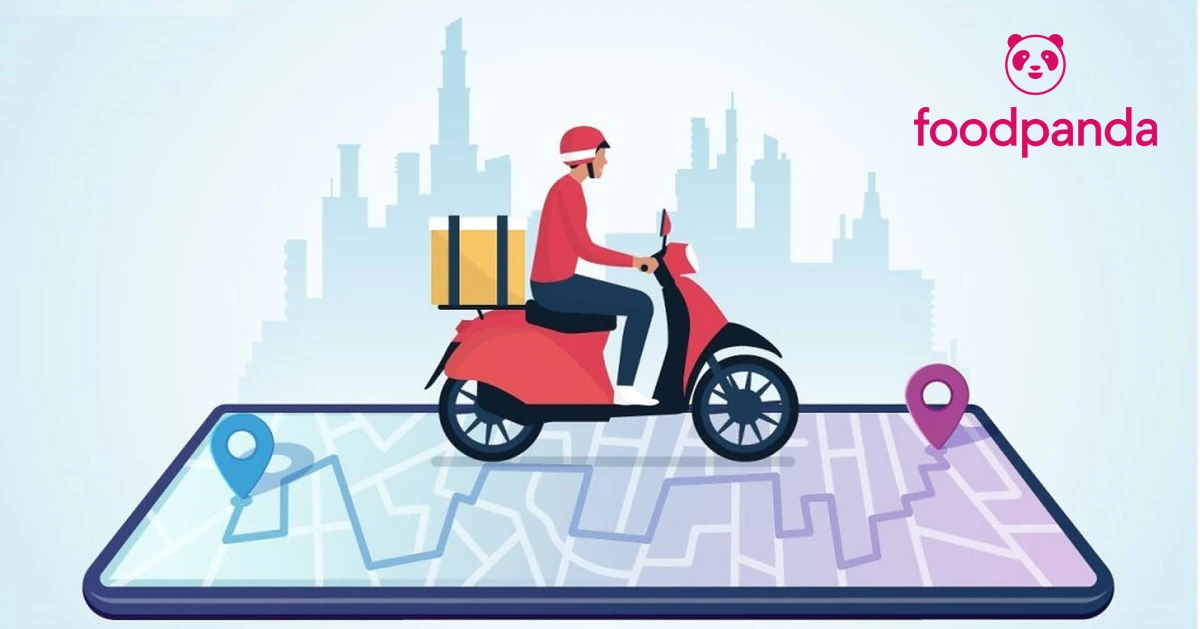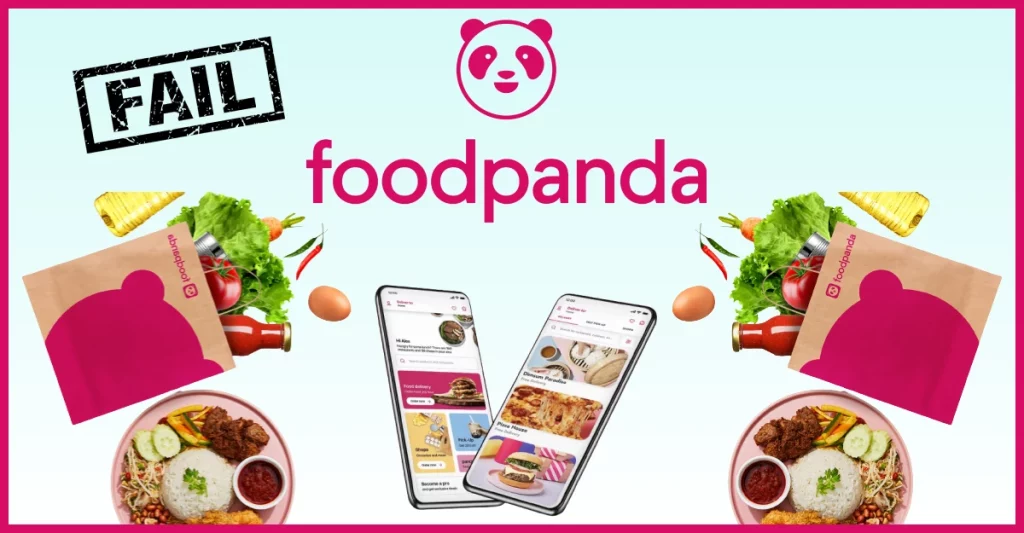FoodPanda, once a blooming food delivery app, went bankrupt in India. Soon the question- “Why did FoodPanda fail in India?” became the talk of the town.
The failure of FoodPanda made everybody wonder that within no time, your purple patch can turn into a rough patch.

Are you curious to know why did FoodPanda fail in India?
Stick to this write-up and you will soon learn the massive blunders of FoodPanda. Also, we will discuss various lessons that you or any entrepreneur can learn from FoodPanda’s failure.
Stay tuned!
(A) Story so far
What’s the name that pops into your mind when you hear the term “Food Delivery App”? Maybe Zomato or Swiggy! Most of you may think of them as the pioneers of food delivery apps in India. Although they are trendsetters. Surprisingly, the first major food delivery app was FoodPanda!
If you belong to GenX or GenY (millennial), I’m sure you must have heard of/used FoodPanda. Once it gained a sky-high valuation of $3 billion but all of a sudden it collapsed. The founders also exited from the company. And this act served as the last nail in the coffin!
Eventually, it was ready to sell itself for merely $10-15 million…
Such a sad story… Isn’t it?
Before diving deep into the FoodPanda case study, let’s have a brief overview of the company–
| Name of the Company | FoodPanda |
| Industry | Online food and grocery delivery |
| Type of Business | Subsidiary |
| Founded | 26th March 2012 |
| Headquarters | Singapore |
| Founders of FoodPanda (Global) | Lukas Nagel, Rico Wyder, |
| Co-Founders of FoodPanda (India) | Rohit Chadda, Rahul Chadda, Mohit Chadda |
| Headquarters in India | Gurugram (Haryana, India) |
| Acquisition of FoodPanda India | Acquired by Ola |
| Type of Acquisition | All-Share Deal |
| Acquisition Price (Valuation) | $40-$50 million |
| End of FoodPanda India | 2019 |
In India, FoodPanda operated from the year 2012 to 2017. Up to 2015, it was doing well and eventually, it expanded to more than 11 countries and got a valuation of $3 billion.
Sounds like a great achievement!
Soon the tables turned and FoodPanda was surrounded with controversies. These controversies and massive blunders led to the downfall of the pioneer food delivery business in India.
What were those blunders? Go through the next section and you will find out!
(B) Reason: Why did FoodPanda Fail in India?
FoodPanda failed in India due to the following reasons-
| Factors | Key Insights |
| Miscommunications and Leadership Departure | Lack of prompt communication about key figures’ departure. Operational challenges impacting credibility and profitability. |
| Financial Irregularities & Operational Blunders | Instances of financial irregularities and delayed payments. Acquisition-related dissatisfaction and mismanagement. |
| Technological Lag and Digital Ineffectiveness | Struggles with technological upgrades and flawed digital strategies. Inadequate mobile app and flawed customer retention plan. |
| Poor Management and Ineffective customer Experience | Operational challenges leading to customer dissatisfaction. Poor communication, delayed deliveries, and negative company image. |
| Co-founders Parallel Venture and Employee Resignations | Co-founder’s parallel venture raising transparency concerns. Mass resignations reflecting negative leadership perception. |
| Lack of Adaptation to Market Demands | Failure to adapt despite being the first flood delivery app in India. Issues with variety, fake orders, miscommunication, and more. |
Now, let’s dive into the details-
(B.1) Miscommunications and Leadership Departure
The miscommunication issue was one of the most pivotal factors contributing to FoodPanda’s downfall in India. The departure of key figures, including Rohit Chadda and Mohit Chadda, in August 2016 was not promptly communicated to employees. As a result of this lack of transparency, the company faced operational challenges. It affected the overall credibility and profitability of the company.
The story doesn’t end here. The workers faced immense difficulties in handling customer inquiries about disrupted services. Guess what? The compensatory measures like free vouchers further impacted the company’s profitability.
(B.2) Financial Irregularities and Operational Blunders
Furthermore, the instances of financial irregularities, including delayed payments and lack of proper procedures, tarnished FoodPanda’s reputation. The failure to record transactions, as highlighted in the case of a Mumbai-based fast-food chain in May 2016, revealed operational blunders and a lack of financial transparency.
The acquisition of Tasty Khan didn’t prove to be good either. The founder of Tasty Khan, Shachin Bharadwaj expressed dissatisfaction too. Reason? Due to issues like no checks for fake orders, mismanagement, and financial irregularities.
(B.3) Technological Lag and Digital Ineffectiveness

In an era dominated by digital advancements, FoodPanda struggled to keep up with technological upgrades. Despite attempts to adapt, the company’s shift towards becoming a technology-centric entity fell short. Some of the major issues were-
- Inadequate mobile app
- Listings of non-existent restaurants
- Overall flawed plan for customer retention
All these acts showcased the company’s failure to meet the demands of a digital-centric consumer base.
(B.4) Poor Management and Ineffective Customer Experience
See, all the reasons are related to each other. The technological lag and digital ineffectiveness of FoodPanda led to severe challenges in managing its operations. Eventually, it led to customer dissatisfaction and disputes with customers and restaurants.
Poor communication and delayed delivery reasons resulted in a negative image for the company. FoodPanda became incapable of capturing all placed orders. Also, it failed to communicate cancellations to restaurant partners. These factors further exacerbated the issues.
The overall poor management, stemming from communication breakdowns and ineffective systems, created a cycle of ineffectiveness and operational blunders.
(B.5) Co-founder’s Parallel Venture and Employee Resignations
Rohit Chadda, FoodPanda’s co-founder, simultaneously founding another venture named Ziner raised concerns, with the website displaying dates identical to FoodPanda’s servers. While Chadda insisted on no data transfer from FoodPanda, this raised eyebrows. More than a hundred employees across various cities left FoodPanda, citing poor management and lack of transparency as reasons. The mass resignations further reflected the negative perception of the company’s leadership and operational practices.
(B.6) Lack of Adaptation to Market Demands
FoodPanda’s failure in India can be attributed to its inability to adapt to market demands. Despite being the first major food delivery app in the country, the company failed to provide a sufficient variety of home delivery options. Issues such as fake restaurants and orders, miscommunication, technical faults, and an unstructured business model contributed to operational inefficiencies and financial challenges. Ultimately, these factors led to FoodPanda’s downfall.
(B.7) Fake Deliveries at FoodPanda

In navigating the challenges at FoodPanda, the issue of fake deliveries stands out prominently. With the introduction of a delivery-based payment system, agents were incentivized to complete more deliveries.
However, miscommunication within the FoodPanda app caused delays in notifying restaurants of incoming orders. Consequently, delivery agents often found unprepared orders upon arrival, leading to significant wait times of 30 to 60 minutes.
Faced with the pressure to fulfill numerous orders swiftly, some agents resorted to fake deliveries, a detrimental practice that tarnished FoodPanda’s public image. Customers, expecting timely deliveries, were left disappointed, eroding trust in the platform.
Fake deliveries, among other operational issues, contributed to substantial losses, ultimately leading to the shutdown of FoodPanda’s India business in 2019.
(B.8) Free Vouchers Backfired
As you delve into FoodPanda’s tumultuous journey, the distribution of free vouchers and financial irregularities emerged as pivotal challenges. In an attempt to placate dissatisfied customers, FoodPanda extensively handed out free vouchers, intending to calm frustrations over late or canceled orders. Unfortunately, this strategy, while well-intentioned, backfired, contributing to substantial financial losses for the company.
If you focus on the solutions to the blunders made by FoodPanda, you can better navigate the competitive food delivery market in India.
(C) Aftermath of FoodPanda’s Failure

By now you have seen the topsy-turvy journey of FoodPanda. Though its founders quit the company, but still like any other business it was looking for a way to survive. It was even ready to sell itself at dramatically low prices of $10-$15 million.
So who acquired FoodPanda India?
It was Ola! Yes, the Ola cab services that you use. Can a cab service provider become an online food delivery business? You may wonder.
Well, Ola offers various services like-
- Rental Vehicles
- Cabs
- Financial Services
- Food Delivery
Note: We have already covered it in detail in the article “Success Story of Ola.” Check it out for detailed information.
Let’s come back to our discussion of what happened to FoodPanda after it was acquired by Ola.
See, in December 2017, Ola took over Foodpanda’s operations in India through a share-based deal ranging from $40 million to $50 million.
Ola wasn’t done there – they planned to inject an additional $200 million into Foodpanda. The move was strategic, with Ola introducing discounts to spike usage, resulting in a peak of 200,000 daily orders in August 2018.
However, fast forward to mid-2019, and those daily orders plummeted to a mere 5,000. Ola responded by hitting the pause button on Foodpanda India’s food delivery and letting go of a significant chunk of their food delivery team.
Despite the setbacks, the Foodpanda brand persisted, shifting its focus to in-house brands and cloud kitchens. The concept of cloud kitchens came into play when Ola acquired Holachef in October 2018. Come 2019, the cloud kitchen business featured only three private label brands, including FLRT and Great Khichdi Experiment.
(D) Key Takeaways from FoodPanda’s Failure
Now, the question is- What did you learn from the failure of FoodPanda in India? The following table describe the crucial lessons from FoodPanda’s failure-
| Takeways | Details |
| Establishing a Proper Framework | Prioritize a well-defined operational structure aligned with your business plan for sustained effectiveness. |
| Prioritizing Communication for Structuring | Emphasize effective communication within your team for a positive work environment. |
| Keeping the Vision Clear | Maintain a clear vision, improving the internal environment amidst external uncertainties. |
| Mastering Internal Control and Management | Navigate the business landscape with effective internal control, addressing communication and ownership issues. |
| Systematic Documentation of Processes | Incorporate systematic documentation for certainty and stability, providing a robust foundation for success. |
Go through the following points for detailed information-
(D.1) Establishing a Proper Framework
Ever played Jenga? Just like a wobbly tower, Foodpanda lacked a sturdy setup. Lesson one: your business needs a strong structure. Picture it like building a house – you want those walls to stand tall!
Learn from Foodpanda’s shortcomings by recognizing the necessity for a well-defined operational structure aligned with your business plan. Prioritize good corporate governance and continuously refine your framework for sustained effectiveness.
(d.2) Prioritizing Communication for Structuring
Avoid the pitfalls of poor communication witnessed at Foodpanda. Imagine planning a surprise party without saying a word. That was Foodpanda’s communication blunder. Lesson two: chatter matters. Keep the talk flowing in your team, and watch the vibes get better.
Emphasize the importance of effective communication within your team, fostering a positive work environment through ongoing improvements in your communication structures.
(d.3) Keeping the vision clear
Ever tried walking with foggy glasses? Foodpanda’s founders did when they left, and the vision got blurry. Lesson three: never lose sight. Hold on to your vision, even when the path gets misty. It’s like having a treasure map in hand!
Take a cue from Foodpanda’s blurred vision after the departure of its founders. Acknowledge the significance of maintaining a clear vision and committing to improving your internal environment, especially in the face of external uncertainties.
(d.4) Mastering Internal Control and Management
Navigate the unpredictable business landscape by recognizing the pivotal role of internal control and management in your venture’s success. Address communication and ownership issues proactively to build a resilient organizational culture.
(d.5) Systematic Documentation of Processes
Incorporate systematic documentation into your approach for a strategic advantage. This practice adds certainty and stability to your endeavors, providing a robust foundation for success in the ever-changing business world.
(E) Wrapping Up: Why did FoodPanda fail in India?
By now you must have understood why did FoodPanda fail in India. Reflecting on FoodPanda’s journey in India, its challenges offer valuable insights. The absence of a strong operational structure, akin to a shaky foundation, and insufficient management were key contributors to its struggles.
Communication gaps strained relationships with customers and restaurants. The departure of the founders further blurred the company’s vision. Take these lessons to heart – prioritize a robust operational framework, enhance communication practices, and maintain a clear organizational vision.
As you navigate the competitive landscape, heed these principles to fortify your venture, ensuring a stronger foundation, effective communication, and strategic clarity for enduring success!

